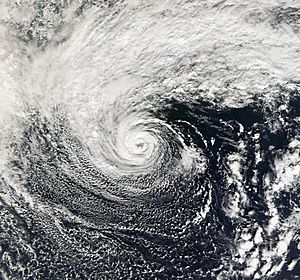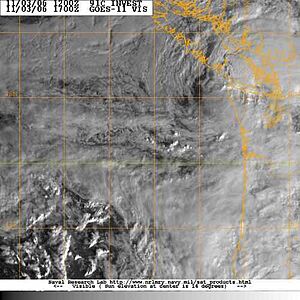2006 Central Pacific cyclone facts for kids
The 2006 Central Pacific cyclone, also known as 91C.INVEST or Storm 91C, was a very unusual weather event in 2006. It started on October 30 as a regular extratropical cyclone (a type of storm that forms outside the tropics) in the northern Pacific Ocean. But then, it moved over water that was warmer than usual. This made the storm start to act like a subtropical cyclone or even a tropical cyclone (like a hurricane).
However, as it got closer to North America, it began to fall apart. The moisture left over from the storm then caused a lot of rain in British Columbia, Canada.
How the Storm Formed and Moved
A storm called an extratropical cyclone was located over the central north Pacific Ocean. This storm moved into an area where the ocean water was about 2 °C (3.6 °F) warmer than normal for two days. By October 31, the storm started to show signs of becoming more organized. It developed convection (strong thunderstorms), a warmer center, and even an eye-like feature. During this time, it moved east, then northeast, and then northwest.
On November 1, the storm had its strongest winds, estimated at 100 km/h (60 mph). It also had its most developed thunderstorms. After that, the storm slowly became weaker. It moved in a counter-clockwise direction and headed east towards the west coast of North America. By November 2, strong wind shear (winds blowing in different directions at different heights) started to break the storm apart. All the thunderstorms were gone by November 3. At that time, the storm was about 840 km (520 mi) off the coast of Oregon.
The center of this storm passed south of a special buoy (a floating weather station) called 46637 on November 1. The buoy measured a low pressure of 989 mb/hPa. Other buoys also showed that a very large area of low pressure was connected to this storm. Since buoy 46637 was not exactly in the storm's center, it's possible the storm's lowest pressure was even lower than what was measured.
What Happened and Special Records
Because of this weather system, the American National Weather Service issued wind watches for the coast of Oregon. The storm also brought heavy rain to parts of Vancouver Island in Canada.
If Storm 91C is officially recognized as a tropical or subtropical cyclone, it would hold several records. However, since it's not officially classified as one yet, these records are unofficial.
- Northernmost Formation: This storm formed at 36°N latitude. This would make it the farthest north a storm has ever formed in the eastern north Pacific basin. The previous record was held by Tropical Storm Wene, which formed at 32°N.
- Crossing Basins: The storm's path shows it moved from the central Pacific to the eastern Pacific. It formed at 149°W longitude and ended at 135°W. Only two other known tropical cyclones have done this before.
What Kind of Storm Was It?
Scientists have different ideas about what kind of storm this was. Some think it was a tropical cyclone, others a subtropical cyclone, and some believe it was an extratropical cyclone.
- Mark Guishard, a weather expert from Bermuda, thought it had become a true tropical cyclone.
- Another weather expert, Mark Lander, said the storm's cloud tops looked like those of some Atlantic hurricanes, such as Hurricane Vince.
- James Franklin, a meteorologist at the National Hurricane Center, explained that the storm started from a "front" (a boundary between two air masses). He said it later lost this frontal structure. He felt its thunderstorms and wind patterns were more like a tropical storm than a subtropical one. He concluded it was "more tropical than subtropical."
- Clark Evans from Florida State University reported that his computer models showed the storm's structure was like a subtropical cyclone or a weak tropical cyclone.
- NASA, which studies space and Earth, also thought it was a subtropical cyclone.
However, the Canadian Hurricane Centre reviewed the storm and said it was an extratropical cyclone.
This storm had strong winds of 100 km/h (60 mi/h). This speed is above the 60 km/h (39 mi/h) needed for a storm to be named if it were a tropical or subtropical cyclone. But the official weather centers for this area, the National Hurricane Center and the Central Pacific Hurricane Centre, do not include this storm in their official records. This means the 2006 Central Pacific cyclone is not officially recognized as a tropical or subtropical cyclone of the 2006 Pacific hurricane season.



